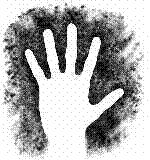Our Logo
The ALI logo, the negative impression of a human hand such as seen in rock art throughout the world, was chosen to symbolize our commitment to sharing with all human beings the story of the cultural legacy belonging to all members of our species.

We searched for a symbol that was recognizably human, yet not associated with any particular culture or region of the world or with either males or females. We also desired a symbol that could represent the time depth of recognizably human cultures.
We feel that the hand impression not only meets these criteria, but also suggests our human self-awareness and our innate drives to communicate and to seek recognition. To our eyes, the hand on the cave wall cries out "I was here!" and signifies to us that we were there. The signature of the cave artist is the signature of our human ancestors. In a very meaningful sense it is our signature, representing the human presence in the world. It may also serve to remind us that the human presence in the world today is indelibly marked into the face of the planet and challenges us to create a sustainable future for ourselves and our fellow creatures. By exploring our past we may gain some of the wisdom needed to find our way into the future.
The Hand Motif Worldwide
The negative hand motif, created by spraying liquid pigment (usually black or red) from the mouth over the hand, is found in ancient rock art in many parts of the world and has great antiquity. The earliest documented use of this symbol is in Chauvet Cave, a recently discovered site in France with some of the most spectacular rock wall paintings ever found. Here, the cave paintings, including a number of negative hands, have been shown to be 31,000 years old, nearly as old as the earliest evidence of modern humans in Europe. Another recently discovered French site with rock art is Cosquer Cave. Located on the Mediterranean coast, this cave was found by divers who encountered its submerged entrance, which leads upward to an air-filled grotto containing wonderful paintings, including 55 negative hand impressions dated to 27,000 years ago. Somewhat less ancient expressions of this motif are also found in North America at such places as Chinle Wash, Arizona, and at many places in Australia, such as Carnarvon Gorge. A pictorial worldwide survey of the hand symbol in rock art has been posted by the Bradshaw Foundation, which illustrates examples from 27,000 year old French site Gargas Cave and spectacular cave sites in Borneo, Australia, and Argentina.
Our Website
All materials that appear on this site are copyrighted by their creators/owners, and all of whom have given explicit permission to ALI for their online broadcast. ALI does not allow for the copy/edit/redistribution of the content contained on this site without written consent of ALI and/or its content partners. ALI cites Fair Use 17 U.S.C. § 107, for Non-profit Educational Use, for any content that does not have any explicit copyright details. Any other materials not mentioned here are given credit in their presentation, such as in the credits at the end of any such presentations (e.g., videos, etc.).
This website's appearance and theme are based on the theme "Beez 20" by Angie Radtke. It has been modified under the GNU/GPL for non-profit use.
The image used for the background of this website: A Wallpaper of the archaeological site in Tulum, Mexico. This site was home to the local Maya of ancient times.
Certain photography from http://www.sxc.hu
This website was designed and created by Rick Pettigrew and Aaron Martins of ALI.
Other contributers: Jesse Peters, Ian Stanfield, Pete Knox, Ward Ricker, Melisa McChesney, Jordan Henderson, Laura Latona, and Rosie Leung.
